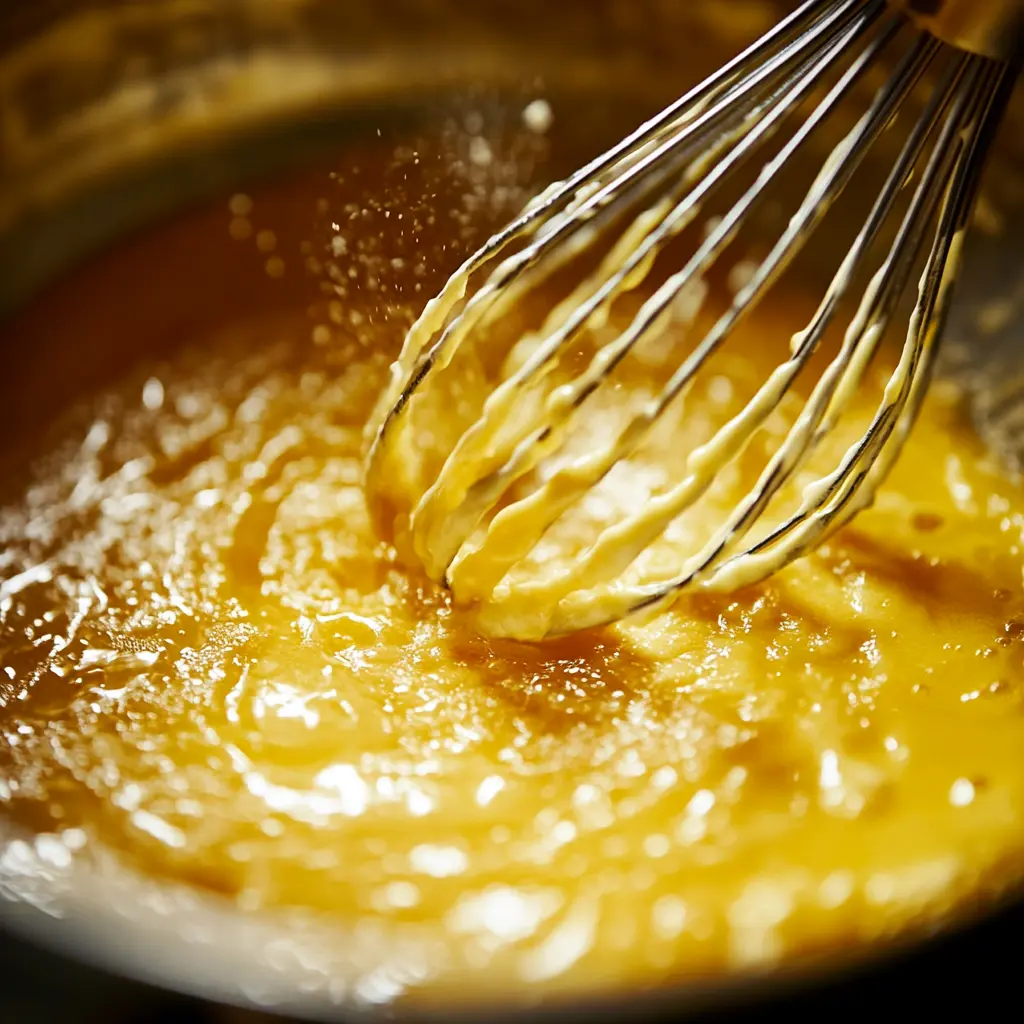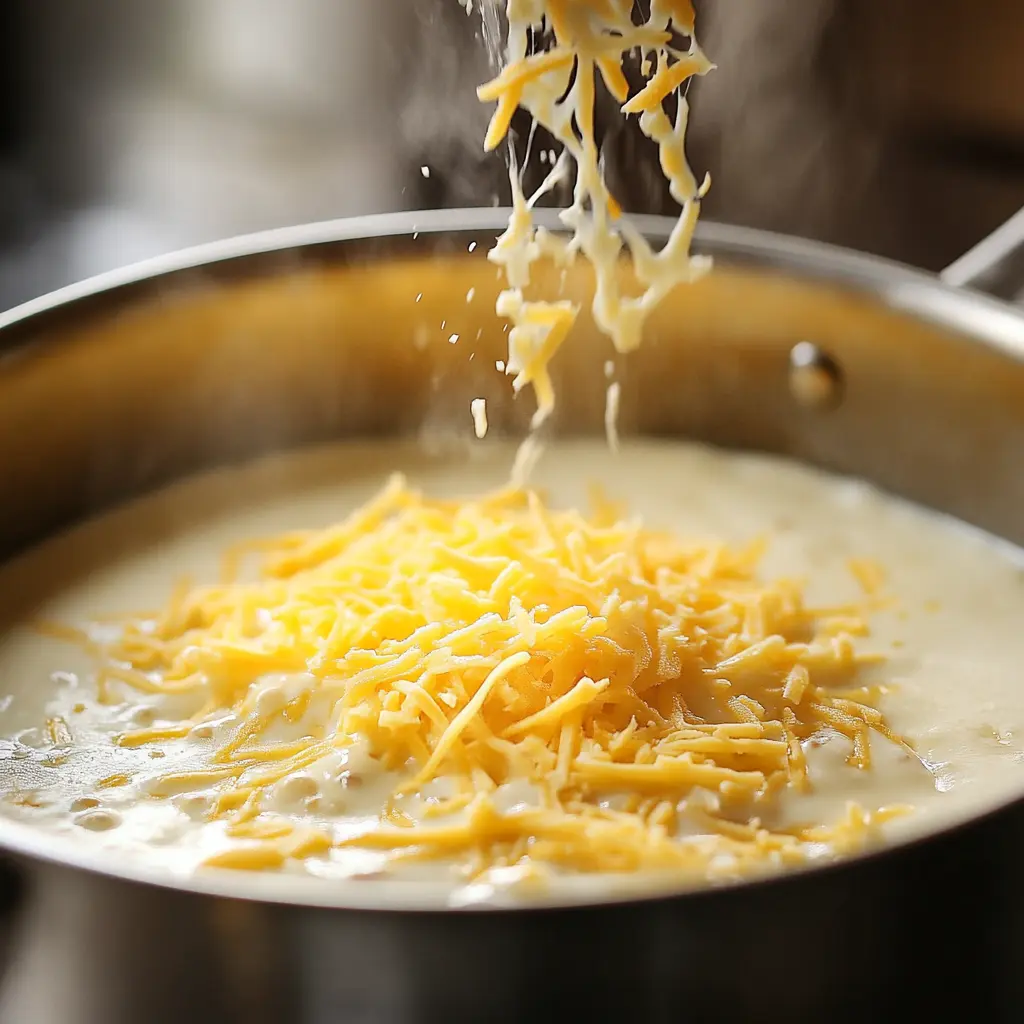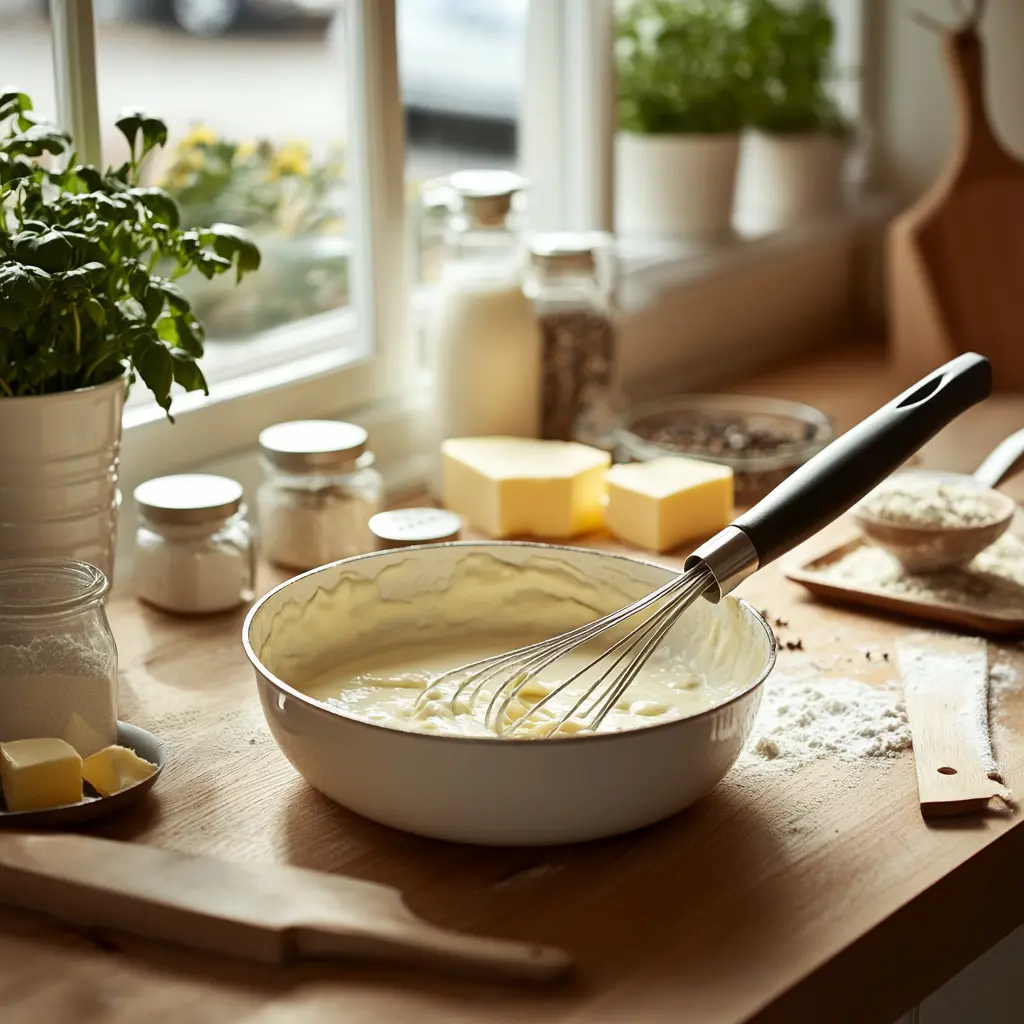White sauce, or béchamel sauce, is a culinary gem in kitchens worldwide. It’s creamy, versatile, and foundational for many classic dishes like pasta, lasagna, and baked vegetables. But what is basic white sauce made of? At its core, it only requires three simple ingredients: butter, flour, and milk. This article will take you on a journey to explore everything about white sauce—from its ingredients and preparation to exciting variations and culinary uses. So, grab a whisk and let’s get started!
Part 1: Understanding Basic White Sauce
The Origin and History of White Sauce
White sauce, also known as béchamel sauce, has roots tracing back to French cuisine. It was introduced as one of the “mother sauces” of French cooking by the legendary chef Auguste Escoffier. Historically, it gained prominence in European kitchens during the 17th century and quickly became a staple for chefs and home cooks alike. Its simplicity and adaptability made it timeless, and today, it’s the base for countless recipes worldwide.
Interestingly, white sauce embodies minimalism, yet it elevates even the simplest dishes. Chefs love it because it forms the perfect canvas for creating creamy textures and layering flavors. No wonder it’s referred to as the foundation of French cooking!
What is Basic White Sauce Made Of?
The magic of white sauce lies in its simplicity. At its heart, it combines three essential ingredients:
Primary Ingredients
- Butter: It provides richness and acts as the fat to bind the flour. Use high-quality butter for a smooth, creamy base.
- Flour: Typically, all-purpose flour works best for forming the roux, which thickens the sauce.
- Milk: Whole milk is preferred for its creaminess, but other alternatives can also work well.
These three ingredients create a silky, smooth sauce when combined in the right proportions. But wait, there’s more!
Optional Add-Ons
While the basic white sauce only needs butter, flour, and milk, a pinch of seasonings can transform its taste:
- Salt: Enhances flavor and balances richness.
- Pepper: Adds a mild kick.
- Nutmeg: A pinch of nutmeg gives the sauce a subtle depth, though it’s entirely optional.
Why Each Ingredient Matters
Each component plays a specific role in creating the perfect white sauce:
- Butter: Melting butter ensures the flour cooks evenly without burning.
- Flour: Cooking the flour eliminates its raw taste and provides thickness.
- Milk: Gradually adding milk prevents lumps and gives the sauce its creamy consistency.
Using precise ratios is critical to achieving the right thickness. For instance, equal parts butter and flour are key to forming a perfect roux. Adding milk in stages ensures the sauce stays lump-free and smooth.
By understanding how each ingredient works together, you can easily master the art of making white sauce—whether for pasta, lasagna, or creamy soups.
Part 2: Step-by-Step Guide to Making Basic White Sauce
So, you now know what basic white sauce is made of—but how do you bring these humble ingredients together to create that creamy, velvety perfection? Don’t worry; it’s easier than you think! Follow this detailed step-by-step guide to make the perfect white sauce every time.

Tools You Need
Before you begin, gather these kitchen essentials:
- A saucepan: Preferably non-stick or heavy-bottomed to prevent burning.
- A whisk: The secret weapon for a lump-free sauce.
- A measuring cup and spoons: Precision ensures the best results.
With the right tools ready, you’re set for the magic to happen!
Step-by-Step Instructions
Step 1: Melt the Butter
- Place the saucepan on medium heat and add the required amount of butter.
- Allow it to melt slowly without browning. Browning butter can alter the flavor of the sauce, and we want it light and creamy!
Pro Tip: Stir the butter gently with a whisk or wooden spoon to ensure even melting.
Step 2: Add the Flour to Make a Roux
- Once the butter is fully melted, add an equal amount of all-purpose flour.
- Whisk continuously for about 1–2 minutes. This step is called making a roux. The flour should blend completely with the butter and form a smooth paste.
Why whisk continuously? Because it prevents the flour from forming clumps and ensures the raw flour taste cooks off. The mixture should have a pale, golden color—avoid browning it too much!
Step 3: Gradually Add the Milk
Here’s where the magic begins!
- Slowly pour in warm milk while whisking vigorously. Adding milk gradually (not all at once!) helps avoid lumps.
- Keep whisking as the mixture thickens. Initially, it will seem watery, but as it heats up, the sauce will start to come together beautifully.
Pro Tip: Use room-temperature or warm milk. Cold milk can shock the roux and make it lumpy.
Step 4: Cook to the Desired Consistency
- Continue whisking for 5–7 minutes until the sauce thickens to your preferred consistency.
- If the sauce coats the back of a spoon and holds its shape when you run a finger through it, it’s ready!
At this stage, you can add a pinch of salt, pepper, and nutmeg for seasoning. Remember, a little goes a long way, so taste as you go.
Common Mistakes and How to Avoid Them
Even though making white sauce seems simple, it can go wrong if you’re not careful. Here are a few common pitfalls and tips to steer clear of them:
- Lumpy Sauce: The number one culprit? Not whisking continuously or adding milk too quickly. Always whisk while pouring the milk gradually.
- Sauce Too Thick or Thin: If the sauce is too thick, add a splash of milk to loosen it up. If it’s too thin, let it simmer longer to reduce.
- Burning the Roux: Cooking the flour for too long can give the sauce a bitter, burnt taste. Keep the heat on medium and stay vigilant!
Quick Fix Tip: If your sauce still ends up lumpy, don’t panic! Pass it through a fine-mesh strainer or give it a quick blitz with a hand blender.
Tips for Perfect White Sauce Every Time
- Consistency is Key: Adjust the amount of milk for thicker or thinner sauce, depending on the dish.
- Low to Medium Heat: Rushing the process by using high heat can ruin the sauce. Be patient!
- Use Fresh Ingredients: High-quality butter and fresh milk make a world of difference.
And here’s a bonus tip—if you want to store white sauce for later, allow it to cool completely, transfer it to an airtight container, and refrigerate. It can last up to 3 days. When reheating, add a splash of milk and whisk it well to restore its smooth texture.
By following these steps and avoiding common mistakes, you’ll have a foolproof white sauce recipe to use as a base for endless dishes. Whether you’re layering it in lasagna, pouring it over steamed veggies, or using it in a creamy soup, mastering the basics ensures delicious results every single time.
Part 3: Variations and Uses of White Sauce
Now that you’ve mastered the basic white sauce, let’s explore its versatile variations and how you can use it to elevate different dishes. The beauty of white sauce lies in its adaptability—it can be thick, thin, cheesy, or even completely vegan!
Different Variations of Basic White Sauce
Thicker or Thinner White Sauce
The consistency of white sauce can be adjusted to suit your needs:
- For thicker white sauce, increase the amount of flour slightly or let the sauce simmer longer. This works best for baked dishes like lasagna.
- For thinner white sauce, add more milk gradually until you achieve the desired texture. It’s perfect for pouring over vegetables or as a light soup base.
Adding Cheese to Make Cheese Sauce
If you love cheese, turning white sauce into a creamy cheese sauce is effortless! Simply:
- Once your white sauce is ready, remove it from the heat and stir in grated cheese (cheddar, parmesan, or mozzarella).
- Whisk until the cheese melts completely, giving you a silky, flavorful sauce.
This variation is ideal for macaroni and cheese, nachos, or drizzling over baked potatoes.

Vegan and Gluten-Free Alternatives
Good news—white sauce can cater to everyone’s preferences!
- Vegan White Sauce: Replace butter with plant-based margarine or olive oil and use unsweetened plant milk like almond, soy, or oat milk.
- Gluten-Free White Sauce: Swap all-purpose flour with gluten-free flour blends or cornstarch. Make sure to whisk well to avoid lumps.
These alternatives ensure that everyone can enjoy the creamy goodness of white sauce, regardless of dietary restrictions.
Popular Dishes That Use Basic White Sauce
The versatility of white sauce means it’s a star ingredient in numerous dishes across cuisines:
- Pasta Dishes
- Creamy Alfredo pasta or baked pasta with cheesy white sauce.
- Lasagna and Baked Casseroles
- Layer white sauce between pasta sheets, vegetables, or meat for a decadent baked lasagna.
- Vegetable Gratins
- Pour white sauce over steamed vegetables, sprinkle some cheese, and bake until golden.
- Soups and Stews
- Use a thinner version of white sauce to make cream-based soups, such as creamy mushroom or chicken soup.
- Savory Pies
- Add white sauce as a filling base for chicken or vegetable pies.
Whether you stick with the classic version or explore these variations, white sauce is a game-changer in the kitchen. Its ability to complement everything—from pasta to casseroles—makes it a must-have recipe for every home cook.
Part 4: Tips, Storage, and Serving Ideas for White Sauce
Once you’ve perfected your basic white sauce, knowing how to store it, reheat it, and serve it can make life in the kitchen a whole lot easier. Whether you’re making it ahead for a special dinner or whipping up a quick meal, these practical tips will keep your white sauce smooth, creamy, and ready to elevate any dish.
Tips for Perfect White Sauce Every Time
No matter how many times you make white sauce, a few handy tricks will ensure perfection:
- Whisk, Whisk, Whisk!
- Stir constantly, especially when adding milk, to avoid lumps. A good whisk is your best friend here.
- Season Gradually
- Add a pinch of salt, pepper, and nutmeg at a time. Taste as you go to avoid over-seasoning.
- Temperature Matters
- Use room-temperature or warm milk. Cold milk can shock the roux and make it harder to blend.
- Don’t Rush
- Patience is key! Cook the sauce on low to medium heat to prevent burning and ensure a smooth, silky texture.
How to Store White Sauce
Made too much white sauce? No problem! You can store it for later use:
- Refrigerator: Let the sauce cool completely. Pour it into an airtight container and refrigerate for up to 3 days.
- Freezer: White sauce can be frozen for up to 2 months. Use freezer-safe bags or containers to save space.
Pro Tip: Before storing, place a layer of plastic wrap directly on the surface of the sauce. This prevents a skin from forming as it cools.
Reheating White Sauce
To reheat, simply follow these steps:
- Pour the chilled or thawed sauce into a saucepan.
- Heat it on low, stirring constantly to bring back its creamy texture.
- Add a splash of milk if the sauce is too thick. Whisk until smooth.
Avoid microwaving white sauce without stirring, as it can become lumpy or unevenly heated.
Serving Ideas for White Sauce
Here are a few quick ways to serve your homemade white sauce:
- Pour it over steamed vegetables like broccoli, cauliflower, or carrots.
- Use it as a creamy base for chicken or vegetable pies.
- Drizzle it over freshly baked pasta or use it to create a layered lasagna.
- Mix it with cheese and serve as a delicious cheese dip for breadsticks.
With these tips, you’ll never have to worry about leftovers, and you’ll always have a go-to sauce for last-minute meals!
FAQs About White Sauce
You’ve now learned what basic white sauce is made of and how to make it perfectly. But let’s tackle some of the most common questions people have about this creamy kitchen staple.
1. What are the main ingredients in basic white sauce?
The essential ingredients are butter, flour, and milk. These three items create the base, with optional seasonings like salt, pepper, and nutmeg for added flavor.
2. Can I make white sauce without butter?
Yes! You can substitute butter with olive oil, margarine, or other plant-based fats for a dairy-free alternative. This works especially well for vegan dishes.
3. What’s the difference between béchamel sauce and white sauce?
Béchamel is the French culinary term for white sauce. Technically, they’re the same thing, though béchamel may sometimes include specific seasonings like nutmeg.
4. How do I fix lumpy white sauce?
If your sauce turns out lumpy, don’t panic! Use a fine-mesh strainer to remove the lumps, or blend the sauce with a hand mixer or immersion blender until smooth.
5. Can I make white sauce with water instead of milk?
While possible, using water will result in a thinner and less creamy sauce. For better alternatives, try plant-based milk like almond or soy for a similar consistency.
6. How long can I store white sauce in the refrigerator?
White sauce can be stored in an airtight container in the refrigerator for up to 3 days. When reheating, add a splash of milk and whisk well to restore its smooth texture.
7. Is white sauce gluten-free?
Standard white sauce uses all-purpose flour, which contains gluten. To make it gluten-free, use cornstarch, rice flour, or a gluten-free flour blend as a substitute.
8. Can I freeze white sauce?
Absolutely! Freeze white sauce in airtight, freezer-safe containers for up to 2 months. To reheat, thaw it overnight in the refrigerator and warm it gently on the stovetop, whisking to avoid lumps.
With these answers, you’ll have no trouble perfecting your white sauce or troubleshooting any hiccups along the way!
Conclusion
White sauce, or béchamel sauce, is a versatile and essential recipe in any kitchen. Made with just three simple ingredients—butter, flour, and milk—it forms the creamy base for countless dishes, from pasta and lasagna to soups and gratins. With a few simple steps, you can master the art of preparing it perfectly, ensuring smooth, lump-free results every time.
Whether you stick with the classic version, experiment with variations like cheese sauce, or adapt it for vegan and gluten-free needs, white sauce remains a reliable and delicious addition to any recipe. Now that you know what basic white sauce is made of and how to use it, it’s time to get creative in the kitchen and elevate your favorite meals!

